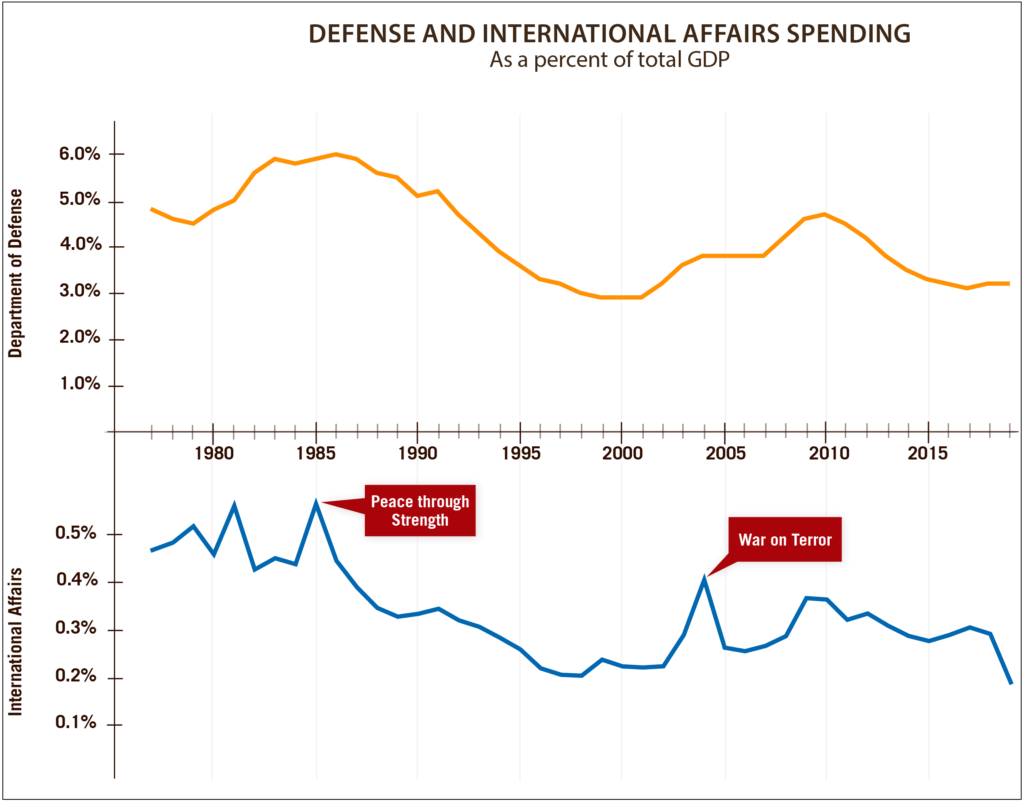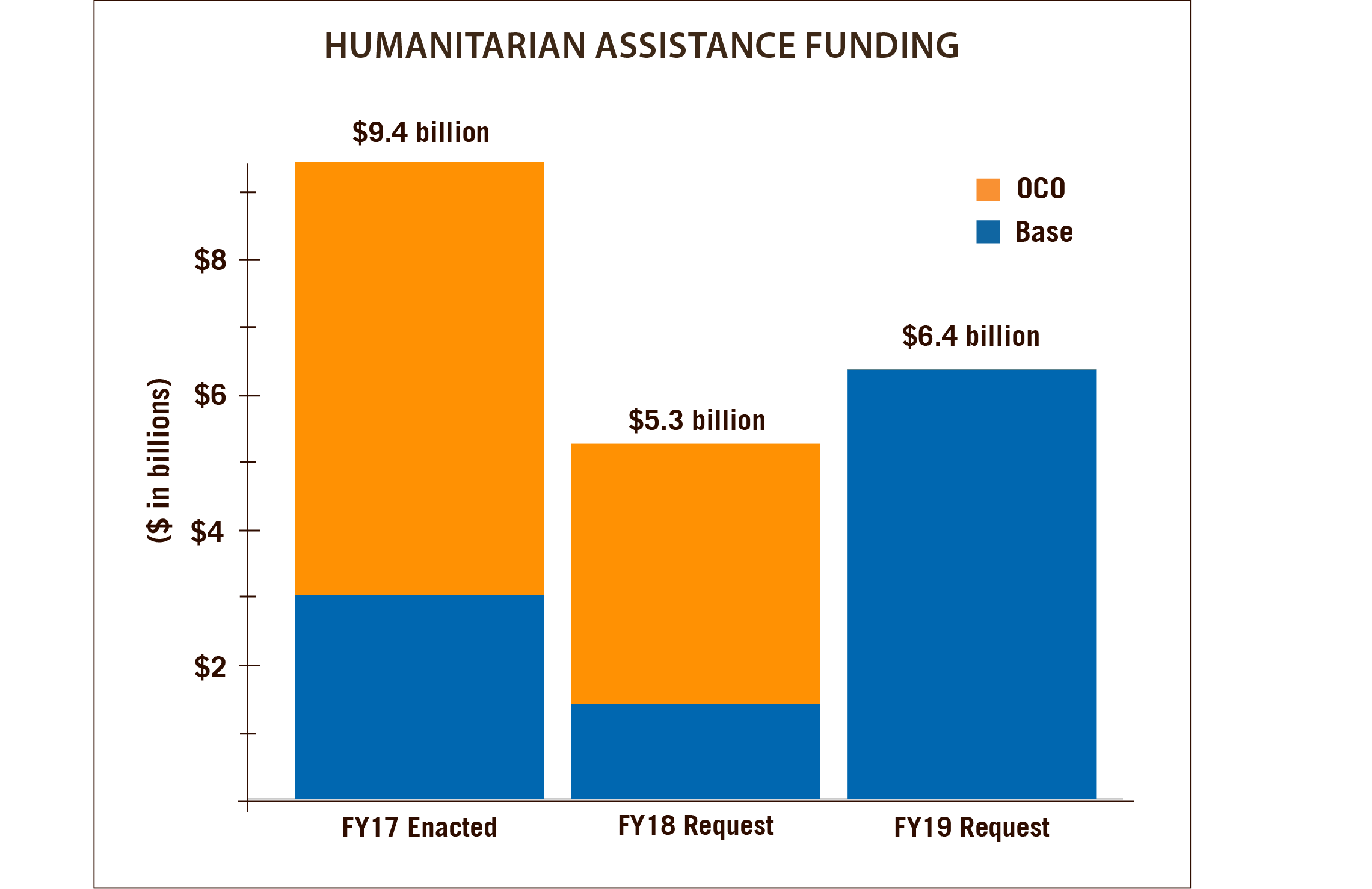
February 12, 2018
var self = document.getElementById(‘me’); var outer = self.parentElement.parentElement.parentElement.parentElement.parentElement; var first = outer.previousElementSibling; var next = outer.previousElementSibling.previousElementSibling.previousElementSibling; first.style.display = “none”; next.style.display = “none”;
The Administration’s Fiscal Year 2019 budget request was sent to Capitol Hill on February 12 – and just like last year, the proposal dangerously slashes funding for the International Affairs Budget by 30%.
Here’s what we know:
The USGLC released this statement urging Congress to once again reject the Administration’s proposed deep cuts and fund the International Affairs Budget at no less than the total FY17 enacted level. The USGLC released a second statement applauding the Administration for its new efforts to strengthen America’s development finance capabilities.
The Administration’s FY19 budget request includes a total of $540 billion in non-defense discretionary (NDD) spending – essentially level with FY17 and $65 billion (9.5%) below the FY19 level included in the budget deal. The budget would cut funding for most discretionary agencies, but once again the International Affairs Budget is one of the hardest hit with a proposed 30% cut. A cut of this magnitude would take funding back to levels not seen since 9/11 (inflation adjusted) and would cut funding for the International Affairs Budget as a percentage of GDP to its lowest level since World War II.
This proposal to again slash funding for development and diplomacy comes despite overwhelming bipartisan opposition in Congress to the Administration’s proposed deep and disproportionate cut in FY18. Senator Lindsey Graham (R-SC) famously called that request “dead on arrival” and more than 230 Members of Congress – from the Freedom Caucus to the Progressive Caucus – spoke out against these dangerous cuts last year.

The National Security Strategy released by the Administration in December calls for the integration of “all elements of America’s national power—political, economic, and military.” While the strategy does not refer specifically to development, diplomacy, and defense as the three pillars of national security – a cornerstone of bipartisan National Security Strategies since 9/11 – it does recognize a whole-of-government approach that includes both military and civilian tools.
However, the Administration’s FY19 budget request rejects the decades-long bipartisan consensus that funding for defense and international affairs proportionally ebbs and flows together as a percentage of GDP. Additionally, for the first time since the State Department and USAID began relying on Overseas Contingency Operations (OCO) funding eight years ago alongside the Defense Department, the Administration’s budget includes no OCO resources for non-defense programs, while at the same time proposing to maintain high levels of OCO funding for defense.
Defense Secretary Jim Mattis has said that America has “two fundamental powers, the power of intimidation and the power of inspiration.” As our military continues to make battlefield gains against ISIS, our civilian forces must be able to maintain those hard-fought gains and prevent bad actors from filling the void. If enacted, the Administration’s proposed deep cuts could severely cripple Secretary Mattis’ vision to advance the “power of inspiration.”

Reflecting the priorities outlined in the National Security Strategy, the FY19 budget request emphasizes economic competitiveness as a guiding principle for U.S. national security and calls for “renewing America’s competitive advantage.” To advance these priorities and in line with the Administration’s efforts to reform the federal government, the budget proposes to consolidate development finance functions – including the Overseas Private Investment Corporation (OPIC) and USAID’s Development Credit Authority (DCA) – into a new standalone U.S. Development Finance Institution (DFI). The request includes $134 million in FY19 to resource the new DFI – including $96 million for administrative expenses, which is $16 million more than provided for OPIC and DCA in FY17 – and provides another $56 million in economic and development assistance for complementary programming.
This commitment to strengthening America’s development finance tools is not only a welcome reversal of the Administration’s FY18 budget request, which proposed eliminating OPIC, but an important opportunity to advance an effective development tool. With bipartisan Congressional interest in modernizing America’s development finance capabilities, this proposal is expected to garner significant support and attention on Capitol Hill.
As part of an Administration-wide effort to create a more efficient, effective, and accountable federal government, the FY19 budget request presents the State Department’s and USAID’s plans to modernize processes, procedures and technologies. Last year’s State Department Redesign has been replaced with a smaller-scale “Impact Initiative” to implement keystone modernization projects focused on three areas:
Under the leadership of Administrator Mark Green, USAID has undertaken its own redesign effort, focused on implementing process and policy reforms to ensure USAID programs promote developing countries’ “journey to self-reliance.” Of particular note are the proposed consolidation of the Office of Food for Peace (FFP) and the Office of Foreign Disaster Assistance (OFDA), and the proposal to merge small grants functions and assistance carried out by the Inter-American Foundation (IAF) and the U.S. African Development Foundation (ADF) into USAID. Both reforms are intended to reduce duplication and strengthen USAID’s humanitarian and development capabilities.
With another deep cut to the topline, the Administration once again proposes cuts to almost every program in the International Affairs Budget compared to FY17 levels. While most of the proposed cuts mirror those in the FY18 budget request, there are some differences worth noting.
Highlights of programs where more resources were added compared to last year’s request:
Highlights of programs where more resources were cut compared to last year’s request:
Like last year, the Administration’s FY19 request consolidates economic and development assistance into a new Economic Support and Development Fund (ESDF) managed by the State Department. The Administration argues that this proposal to streamline four accounts – including the Economic Support Fund (ESF) and Development Assistance (DA) – will increase efficiency and ensure development is focused on strategic priorities.
The consolidated Economic Support and Development Fund is once again cut by a significant 43% compared to FY17 – a 1% increase from the FY18 request. This small improvement in funding allowed the Administration to restore some assistance to 24 of the approximately 37 countries that had been zeroed out in the FY18 request. Congress largely rejected the steep funding cuts and consolidation of these accounts in FY18, noting that the Administration’s proposal had not been justified, and is likely to do so again this year.
The Administration’s budget proposes to cut humanitarian assistance by $3.1 billion (33%) in FY19 compared to FY17 levels. Even with this cut, the Administration states that “the U.S. will remain the largest single donor of global humanitarian assistance” while at the same time encouraging international partners to provide a greater share of this assistance. While this cut is less severe than the 44% reduction proposed in FY18, Congress is likely to express concern that the low funding level fails to keep pace with today’s unprecedented global crises – including 30 million people facing famine and a historic number of displaced people around the world.
Once again, the request eliminates the Title II, PL 480 Food for Peace Program and shifts all emergency food assistance into the International Disaster Assistance (IDA) account. The Administration argues that this approach will provide greater flexibility to respond to food crises based on the unique circumstances on the ground. Notably, the Administration added $1 billion to its FY19 request for IDA after the budget deal was announced, although the request is still $569 million (14%) below FY17 levels. The Administration also proposes eliminating the Emergency Refugee and Migration Assistance (ERMA) account while cutting the Migration and Refugee Assistance (MRA) account by 17%.

The FY19 budget proposes a $2.1 billion (23%) cut to Global Health Programs compared to FY17 despite bipartisan Congressional opposition to the Administration’s proposed deep cuts in FY18. As PEPFAR marks its 15th anniversary, the Administration’s request includes a $1.2 billion (20%) proposed cut to these live-saving programs even after receiving a $400 million boost when the budget deal was announced. Moreover, most other global health programs are cut even more deeply than PEPFAR, and taken as a whole are cut by 30%. Additional details on global health funding are included later in this analysis.
The FY19 request proposes cuts to several accounts that fund the U.S. diplomatic and development presence around the world and appears to implement the Administration’s stated goal of reducing State Department and USAID personnel by 8%. Bipartisan Members of Congress have expressed concerns about the proposed reductions in career personnel and their impact on America’s ability to conduct foreign policy. The request also includes $7.8 billion to cover the State Department workforce and related costs and $1.7 billion for the construction and maintenance of diplomatic facilities – 19% and 45% cuts respectively compared to FY17 levels. Similarly, USAID receives an 18% cut for its operating expenses, which could have a significant negative impact on USAID’s capacity for implementing, monitoring, and evaluating a wide range of foreign assistance programs.